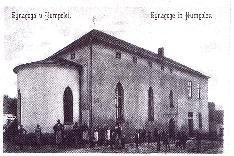Synagogues
The following text was adapted from the History of the Jewish Community in
Humpolec, by Professor Jiri Rychetsky.
 In 1760, the owner of the Heralec and Humpolec domains, Baron Jakub Nefzern, gave his Jewish
subjects his permission to build a synagogue. Construction was funded by the local Jewish
congregation and their co-religionists from out of town. Elements of the Baroque style
prevailed in the original structure. In 1860, the house of prayer was rebuilt and
significantly enlarged in the style of Gothic Revival. A Jewish school was added onto its
western front. In 1862, the school authority officially licensed the Jewish school. Until then,
Jewish and Christian school children were taught alternately at the local Catholic school. The
newly built annex to the synagogue also contained the Rabbi's apartment and the women's
gallery. Around 1870, an apse was built onto the eastern front of the synagogue to accommodate
the choral society, “Shir Zion.”
In 1760, the owner of the Heralec and Humpolec domains, Baron Jakub Nefzern, gave his Jewish
subjects his permission to build a synagogue. Construction was funded by the local Jewish
congregation and their co-religionists from out of town. Elements of the Baroque style
prevailed in the original structure. In 1860, the house of prayer was rebuilt and
significantly enlarged in the style of Gothic Revival. A Jewish school was added onto its
western front. In 1862, the school authority officially licensed the Jewish school. Until then,
Jewish and Christian school children were taught alternately at the local Catholic school. The
newly built annex to the synagogue also contained the Rabbi's apartment and the women's
gallery. Around 1870, an apse was built onto the eastern front of the synagogue to accommodate
the choral society, “Shir Zion.”
The synagogue's Holy Ark (“Aron hak-Kodesh” - the repository of the Torah scrolls covered with a curtain called “parocheth”) faced the east. The interior of the synagogue was entered by several descending steps to fulfill the words of the psalm 'Out of the depths I have cried to You, O LORD'. Its front facade was adorned by a stone image of the Ten Commandments. Only men were allowed to pray in the main synagogue hall (where each of them had his own prepaid seat). Before the building's conversion, the almemar (“bimah” – a platform from which the Torah is read) was in the middle of the prayer hall and the seats were arranged around it. Later, the Torah was read before the Holy Ark where the pulpit (“amud” - cantor's desk) was located, and the faithful sat in pews facing the Ark. The Torah was kept inside the Holy Ark. The Ark curtains used in the Humpolec synagogue were embroidered with silver. The Humpolec community owned three Torah scrolls and many ritual objects made of silver. During the Nazi occupation, these objects were taken to Prague. Today, they belong to the world famous collections of the Jewish Museum. During the latest conversion of the synagogue (which became a prayer hall of the Czechoslovak Hussite Church), remnants of wall paintings depicting plants and fruits mentioned in the Bible were uncovered. The restoration also revealed fragments of biblical inscriptions.
The synagogue is situated at the center of the former Jewish quarter which is still called The Jewish Town. The ghetto itself is located at the southern edge of the town core. The originally compact Jewish settlement comprised about thirty houses forming a small square and several narrow streets. The northwest part of the ghetto was later razed; most of the original houses survived, and they have been rebuilt and preserved.